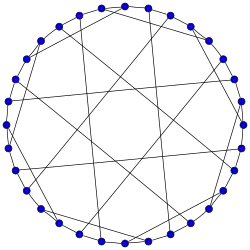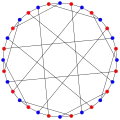| Dyck graph | |
|---|---|
 The Dyck graph | |
| Named after | W. Dyck |
| Vertices | 32 |
| Edges | 48 |
| Radius | 5 |
| Diameter | 5 |
| Girth | 6 |
| Automorphisms | 192 |
| Chromatic number | 2 |
| Chromatic index | 3 |
| Book thickness | 3 |
| Queue number | 2 |
| Properties | Symmetric Cubic Hamiltonian Bipartite Cayley graph |
| Table of graphs and parameters | |
In the mathematical field of graph theory, the Dyck graph is a 3-regular graph with 32 vertices and 48 edges, named after Walther von Dyck.[1][2]
It is Hamiltonian with 120 distinct Hamiltonian cycles. It has chromatic number 2, chromatic index 3, radius 5, diameter 5 and girth 6. It is also a 3-vertex-connected and a 3-edge-connected graph. It has book thickness 3 and queue number 2.[3]
The Dyck graph is a toroidal graph; the dual of its symmetric toroidal embedding is the Shrikhande graph.
Algebraic properties
The automorphism group of the Dyck graph is a group of order 192.[4] It acts transitively on the vertices, on the edges and on the arcs of the graph. Therefore, the Dyck graph is a symmetric graph. It has automorphisms that take any vertex to any other vertex and any edge to any other edge. According to the Foster census, the Dyck graph, referenced as F32A, is the only cubic symmetric graph on 32 vertices.[5]
The characteristic polynomial of the Dyck graph is equal to .
Dyck map
The Dyck graph is the skeleton of a symmetric tessellation of a surface of genus three by twelve octagons, known as the Dyck map or Dyck tiling. The dual graph for this tiling is the complete tripartite graph K4,4,4.[6][7]
Gallery
 Alternative drawing of the Dyck graph.
Alternative drawing of the Dyck graph. The chromatic number of the Dyck graph is 2.
The chromatic number of the Dyck graph is 2. The chromatic index of the Dyck graph is 3.
The chromatic index of the Dyck graph is 3.
References
- ↑ Dyck, W. (1881), "Über Aufstellung und Untersuchung von Gruppe und Irrationalität regulärer Riemann'scher Flächen", Math. Ann., 17 (4): 473, doi:10.1007/bf01446929, S2CID 122956853.
- ↑ Weisstein, Eric W. "Dyck Graph". MathWorld.
- ↑ Wolz, Jessica; Engineering Linear Layouts with SAT. Master Thesis, University of Tübingen, 2018
- ↑ Royle, G. F032A data
- ↑ Conder, M.; Dobcsányi, P. (2002), "Trivalent symmetric graphs up to 768 vertices", J. Combin. Math. Combin. Comput., 40: 41–63.
- ↑ Dyck, W. (1880), "Notiz über eine reguläre Riemannsche Fläche vom Geschlecht 3 und die zugehörige Normalkurve 4. Ordnung", Math. Ann., 17: 510–516, doi:10.1007/bf01446930, S2CID 121904710.
- ↑ Ceulemans, A. (2004), "The tetrakisoctahedral group of the Dyck graph and its molecular realization.", Molecular Physics, 102 (11): 1149–1163, doi:10.1080/00268970410001728780, S2CID 97973403.